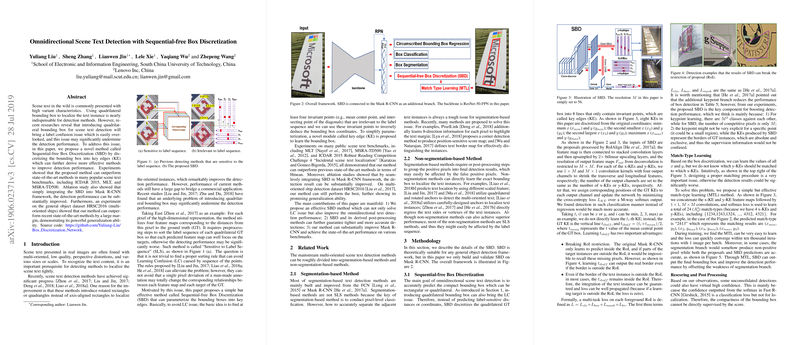Omnidirectional Scene Text Detection with Sequential-free Box Discretization
The paper "Omnidirectional Scene Text Detection with Sequential-free Box Discretization" introduces a method to improve the detection performance of scene text in images with varying orientations and characteristics. Scene text detection has traditionally relied on quadrilateral bounding boxes to localize text, but the authors identify a label confusion issue associated with these bounding boxes that affects detection accuracy.
To address label sequence sensitivity, the authors propose Sequential-free Box Discretization (SBD). Instead of relying on quadrilateral bounding boxes that are sensitive to label sequences, SBD discretizes bounding boxes into "key edges" (KE) that are independent of label order. This approach enhances the robustness of scene text detection frameworks, including popular methods like Mask R-CNN, by reducing label-induced confusion.
Methodology
SBD is integrated into a detection framework, where it learns invariant points key to accurately predicting bounding box coordinates without sequence dependency. Match-type learning is applied to determine the correct matching of x-KEs and y-KEs, ensuring accurate edge predictions. The authors further refine detection confidence via a rescoring mechanism that considers both classification and localization confidences, mitigating false positive rates by leveraging KE predictions.
Experimental Results
The authors validate SBD on several prominent scene text detection benchmarks, including ICDAR 2015, MLT, and MSRA-TD500. The results demonstrate the efficacy of SBD, with significant improvements in recall and precision across datasets. For instance, the method achieved a harmonic mean (Hmean) of 86.5% on the ICDAR 2015 dataset, outperforming other state-of-the-art methods. Additionally, the generalization capability of SBD is illustrated through experiments on the HRSC2016 dataset, where SBD achieved substantial improvements over existing object detection methodologies for multi-oriented objects.
Implications and Future Directions
The Sequential-free Box Discretization approach presents theoretical and practical advancements in handling label sequence sensitivity, benefiting not only scene text detection but also potential applications in general object detection tasks where orientation and varying object characteristics present challenges. Moving forward, further exploration might focus on optimizing computational efficiency and expanding the application of SBD to other object detection frameworks, potentially integrating with novel architectures in AI research for even broader utility.
By offering a robust alternative to traditional bounding box methods, SBD heralds an opportunity for enhancing detection precision in complex image scenarios, thus supporting advancements in automated reading systems, augmented reality applications, and enhanced human-computer interaction interfaces.
